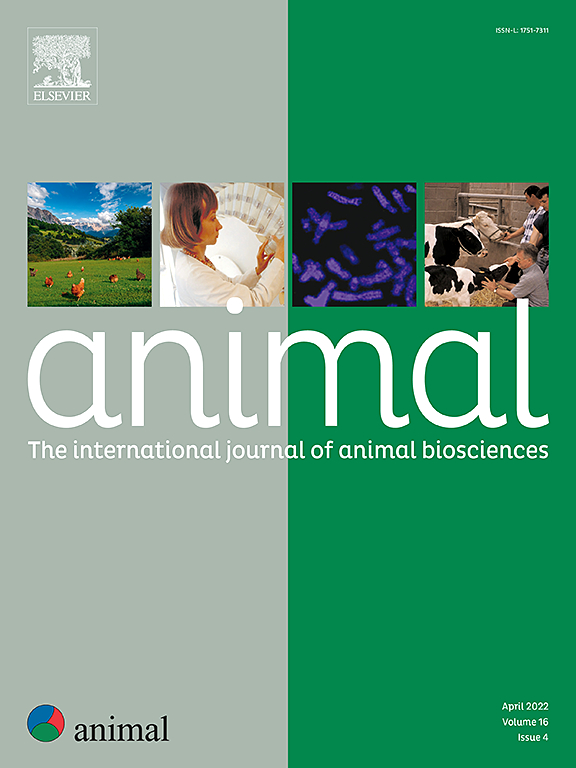Does size really matter? Effects of experimental unit size and relative humidity on the life-history parameters of yellow mealworm
IF 4.2
2区 农林科学
Q1 AGRICULTURE, DAIRY & ANIMAL SCIENCE
引用次数: 0
Abstract
Given the relative novelty of the research in insects as food and feed, experiment protocols often differ among each other, rendering comparison difficult. This experiment aims at assessing the effects of three rearing scales, or the size of the experimental unit, the trays in which larvae are reared. Experimental unit sizes tested were: small (S, 13*13*5 cm), medium (M, 30*20*11 cm), and large (L, 57*36*10 cm), at two relative humidity (RH) conditions (60 and 70%), for a total of 6 treatments. The parameters observed were the growth, bioconversion capacity and nutritional profile of Tenebrio molitor larvae. Each treatment was replicated 5 times. All other parameters were kept constant: genetic origin of the larvae, feed (wheat bran), feeding rate (0.26 g/larva), areal density (4 larvae/cm2), volumetric density (1 larva/cm3) and water source provision (agar, 20 g/l). Trial started with 3-week-old larvae and sampling occurred every 7 days until 5% of pupae were observed in a replicate. Data were analysed using SPSS software (P ≤ 0.05). The different scales did not have a significant effect on the survival of the larvae and the development time at either of the RH tested (P > 0.05). The weight of the larvae was lower at the S scale at both RH (P < 0.001) while the M and L scales were comparable (P > 0.05) under conditions up until larvae were 49 days old. At the end of the trial, differences could only be observed in 60% RH between S and M scales (P < 0.05). Bioconversion efficiency was higher at S scale, with a lower feed conversion ratio (P < 0.001) and a higher efficiency of conversion of ingested feed (P < 0.001). The nutritional composition of the larvae was affected by the scale of the experiment, with the M scale having higher CP and fat content than the S scale (P < 0.001). The temperature of the substrate was affected by the scale of the experiment. Notably, at 60% RH conditions, the temperature of the substrate was lower at S scale than M and L at all times except at the first and last measurements (P < 0.05). In conclusion, the size of the experimental unit has effects on the outcome of experiment. Bioconversion was more efficient in small scale. However, M scale allowed for higher larval growth. Based on these findings, the size of the experimental unit is an important parameter that should be taken into consideration when planning experimental protocols and comparing experiments.
大小真的重要吗?实验单元大小和相对湿度对黄粉虫生活史参数的影响
考虑到昆虫作为食物和饲料的研究相对新颖,实验方案往往彼此不同,使比较变得困难。本试验旨在评估三种饲养尺度或实验单元的大小,即饲养幼虫的托盘的效果。试验单位尺寸为:小(S, 13*13*5 cm)、中(M, 30*20*11 cm)和大(L, 57*36*10 cm),在相对湿度(RH)条件下(60%和70%),共6个处理。观察黄粉虫幼虫的生长、生物转化能力和营养状况。每个处理重复5次。其他参数:幼虫遗传来源、饲料(麦麸)、取食率(0.26 g/条)、面密度(4只/cm2)、体积密度(1只/cm3)和水源供应(琼脂,20 g/l)保持不变。试验从3周龄的幼虫开始,每7天取样一次,直到观察到5%的蛹,重复一次。数据采用SPSS软件分析(P≤0.05)。不同鳞片对两种RH条件下幼虫的存活率和发育时间均无显著影响(P > 0.05)。两种RH条件下,幼虫的S级体重均较低(P < 0.001),而在49日龄前,M级和L级体重相当(P < 0.05)。试验结束时,S和M量表之间仅在60% RH上存在差异(P < 0.05)。S规模下的生物转化效率较高,饲料转化率较低(P < 0.001),而采食饲料转化效率较高(P < 0.001)。幼虫的营养成分受试验尺度的影响,M尺度的粗蛋白质和脂肪含量高于S尺度(P < 0.001)。衬底温度受实验规模的影响。值得注意的是,在60% RH条件下,除了第一次和最后一次测量外,底物在S尺度下的温度一直低于M和L尺度(P < 0.05)。综上所述,实验单元的大小对实验结果有影响。在小范围内,生物转化效率更高。而M型鳞片的幼虫生长速度更快。基于这些发现,实验单元的大小是在规划实验方案和比较实验时应考虑的重要参数。
本文章由计算机程序翻译,如有差异,请以英文原文为准。
求助全文
约1分钟内获得全文
求助全文
来源期刊

Animal
农林科学-奶制品与动物科学
CiteScore
7.50
自引率
2.80%
发文量
246
审稿时长
3 months
期刊介绍:
Editorial board
animal attracts the best research in animal biology and animal systems from across the spectrum of the agricultural, biomedical, and environmental sciences. It is the central element in an exciting collaboration between the British Society of Animal Science (BSAS), Institut National de la Recherche Agronomique (INRA) and the European Federation of Animal Science (EAAP) and represents a merging of three scientific journals: Animal Science; Animal Research; Reproduction, Nutrition, Development. animal publishes original cutting-edge research, ''hot'' topics and horizon-scanning reviews on animal-related aspects of the life sciences at the molecular, cellular, organ, whole animal and production system levels. The main subject areas include: breeding and genetics; nutrition; physiology and functional biology of systems; behaviour, health and welfare; farming systems, environmental impact and climate change; product quality, human health and well-being. Animal models and papers dealing with the integration of research between these topics and their impact on the environment and people are particularly welcome.
 求助内容:
求助内容: 应助结果提醒方式:
应助结果提醒方式:


